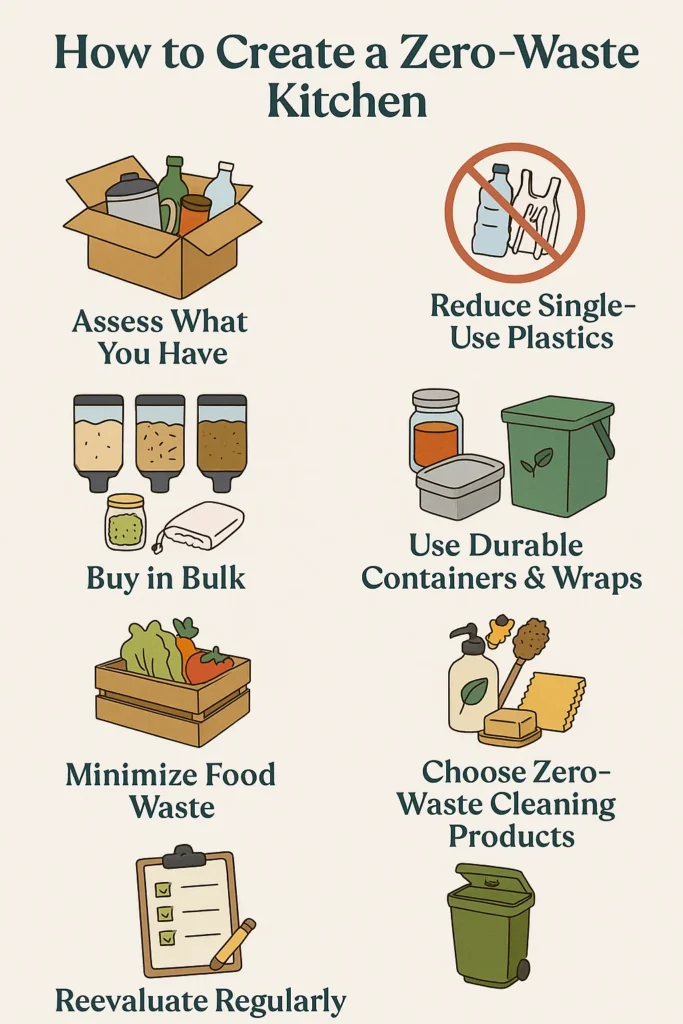Creating a zero-waste kitchen for beginners is a fantastic step toward reducing your environmental impact and living a more sustainable lifestyle. Adopting a zero-waste approach can be empowering and rewarding, as it helps minimize unnecessary waste and encourages mindful consumption. Here’s a step-by-step guide to help you create a zero-waste kitchen that is both beginner-friendly and effective.

What is a Zero-Waste Kitchen?
A zero-waste kitchen is a space where you strive to eliminate waste by rethinking how you buy, use, and dispose of items. The goal is to produce as little waste as possible by following the principles of reduce, reuse, and recycle.
Why Should You Have a Zero-Waste Kitchen?
Benefits:
- Environmental Impact: Reducing packaging and single-use plastics reduces your overall environmental footprint.
- Healthier Choices: By cooking at home and avoiding processed foods, you’re more likely to choose whole, nutritious ingredients.
- Cost Savings: Reusing containers, buying in bulk, and reducing food waste can help you save money.
- Sustainable Living: It helps create a more sustainable lifestyle, inspiring others to do the same.
How to Start Creating a Zero-Waste Kitchen:
1. Assess What You Already Have
Before you rush to buy new zero-waste products, take a look at what you already own. Consider how you can use or repurpose the items you already have. For example:
- Old containers can be repurposed for storing bulk food.
- Plastic bags can be used for organizing or as trash bags temporarily.
- Excess utensils or packaging can be recycled or reused creatively.
2. Reduce Single-Use Plastics
One of the biggest contributors to waste in kitchens is single-use plastics. To reduce your plastic waste:
- Use Reusable Containers: Switch from plastic wrap and disposable bags to reusable glass jars, stainless steel containers, or beeswax wraps.
- Reusable Produce Bags: Invest in cloth produce bags instead of using the plastic ones provided at grocery stores.
- Avoid Bottled Water: Instead of buying bottled water, use a reusable water bottle and a water filter at home.
3. Buy in Bulk
Buying in bulk is one of the easiest ways to reduce packaging waste. Look for local bulk food stores or co-ops where you can purchase dry goods like rice, pasta, grains, nuts, and even spices without packaging.
- Bring Your Own Containers: When shopping in bulk, make sure to bring your own reusable bags or jars to reduce waste.
4. Embrace Composting
Food scraps are inevitable, but instead of throwing them away, composting allows you to turn them into nutrient-rich soil. This not only reduces waste but also helps your garden.
- Start a Compost Bin: You can compost things like vegetable peels, fruit scraps, coffee grounds, and even eggshells.
- Keep a Compost Container: For convenience, keep a small compost container on your kitchen counter to collect food scraps. Just make sure it’s kept in a cool place to avoid unpleasant odors.
5. Choose Sustainable Kitchen Tools
When it’s time to replace or buy new kitchen tools, opt for sustainable, long-lasting materials that are built to last.
- Bamboo or Stainless Steel Utensils: Swap out plastic spatulas or serving spoons for durable bamboo or stainless steel alternatives.
- Wooden Cutting Boards: Wooden cutting boards are not only more durable than plastic but also easier on knives and more eco-friendly.
- Cast Iron Skillets and Stainless Steel Cookware: Invest in high-quality cookware that will last a long time, instead of opting for non-stick, disposable options.
6. Organize Your Kitchen for Waste Reduction
Organization is key when it comes to reducing food waste and managing a zero-waste kitchen.
- Keep a Pantry Inventory: By knowing what you have on hand, you can avoid buying duplicates and reduce food waste.
- Label and Store Properly: Store items in clear, labeled containers so you know what you have and when it will expire.
- Meal Plan: Plan your meals for the week and make a grocery list to reduce impulse buying and avoid food spoilage.
7. Reduce Food Waste
Reducing food waste is a key principle in a zero-waste kitchen. Here’s how you can get started:
- Use Leftovers: Get creative with your leftovers. Transform them into new meals to avoid throwing them away.
- Understand Expiration Dates: Learn the difference between “best before” and “use by” dates. Many foods are still safe to eat after the “best before” date.
- Freeze for Later: Freeze fruits, vegetables, or cooked meals that you won’t be able to use immediately.
Essential Zero-Waste Kitchen Products
Here’s a list of essential items that will make your zero-waste kitchen even more effective:
- Glass Jars & Containers for storing pantry staples.
- Beeswax Wraps to replace plastic wrap.
- Cloth Napkins to eliminate paper towels.
- Compost Bin for food scraps.
- Reusable Straws and Cutlery for on-the-go meals.
- Eco-Friendly Dish Soap and Sponges (look for biodegradable options).
- Bulk Storage Bags for buying in bulk.
- Wooden or Bamboo Utensils to avoid plastic.
Zero-Waste Kitchen Tips:
- Start Slow: Don’t feel like you need to do everything all at once. Gradually incorporate zero-waste habits into your daily routine.
- Shop Locally: Whenever possible, support local farmers’ markets or bulk stores to reduce packaging and support sustainable agriculture.
- DIY Cleaning Products: Create your own cleaning products using natural ingredients like vinegar, baking soda, and lemon juice.
- Repurpose Leftover Scraps: Don’t throw away vegetable scraps or overripe fruit – use them to make broths, smoothies, or compost them.
Conclusion
Creating a zero-waste kitchen may seem overwhelming at first, but taking small, deliberate steps can make a huge difference. Start with the basics – reduce single-use plastics, compost food scraps, and choose reusable items. As you become more accustomed to these practices, you’ll find it easier to maintain a sustainable kitchen that minimizes waste and supports a healthier planet.


Leave a Reply